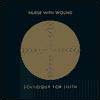After a decade of producing the underground's most radical audio surrealism and twisted sonic mutations, Nurse With Wound unleashed Soliloquy for Lilith onto an unsuspecting public. This triple album of understated electronic drones was miles away from the unhinged kitchen-sink sound sculptures that Nurse With Wound fans had come to expect. Lilith was Stapleton's version of Metal Machine Music, Lou Reed's double album of electronic drones that perplexed a public weaned on the introspective rock of previous work. Just as many did following the release of Metal Machine Music, several critics maintained (and still maintain) that Soliloquy for Lilith was Nurse With Wound's finest accomplishment. I can't have the been the only person who was a bit incredulous about these hyperbolic accolades.
My first reaction to the album was lukewarm. While the material was certainly potent and had a fragile beauty all its own, it couldn't match the unparalleled dynamism of Spiral Insana or the sinister whimsy of Homotopy to Marie. In short, I probably felt as betrayed and confused as the legions of rock kids who bought Reed's Metal Machine Music, dropped the tone arm and made the disheartening discovery that the album was nothing but four sides of grating, atonal noise. Although this kind of experimentalism should perhaps have been more foreseeable coming from the Stapleton camp, I think few were prepared for a Nurse so positively civilized, academic and downright pastoral. Now comes the United Dairies re-release of this, his most confounding work. The album has been re-issued and digitally re-mastered, and comes packaged in a nice box mirroring the original LP artwork. Just to make it completely irresistible, a third disc containing two new pieces recorded in the same method and spirit as the original Lilith pieces is also included. Listening to these sounds again after several intervening years of expanding my own musical education is quite a revelation, and I think that I never truly gave this album a fair chance. Understanding this album as Stapleton's take on the groundbreaking minimalist drone work of LaMonte Young and Charlemagne Palestine gives essential perspective on Stapleton's unique developments.
Soliloquy for Lilith is an album of complex, powerfully realized moods, both somber and fragile; one of the most rewarding "ambient" albums ever made. It was recorded to take advantage of the strange electrical phenomena that occurred when Stapleton discovered ghostly feedback tones emitted from a spiderweb of cross-patched guitar pedals that would elicit varying tones in response to physical movement in the vicinity of the patchwork, much the same way a theremin is played. This fortuitous accident is utilized to stunning effect on the eight sidelong pieces that comprise the album. Giant sheaves of majestic, glacial sound are wielded in repetition, with the inevitable effects of sound decay and distortion creeping in at the high end and bottom tones. It's a gleaming sound full of depth and dimension, like a work of modern metal sculpture in which you can see your distorted reflection. When given your full attention, the coldly warm tones have the effect of rendering thoughts, and therefore time itself, neutral. The same sound palette is used throughout, but each track manages to be very different from the last, birthing its own unique phantasms. The two new pieces are very much in the same vein as the original six, but are perhaps slightly more dynamic than the others. Either way, they're all extraordinarily subtle and stirring works. Soliloquy for Lilith works on its own terms, and it certainly stands the test of time as one of Steven Stapleton's most transcendental experiments.
samples:
Read More


